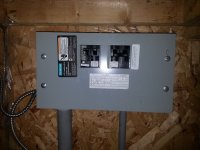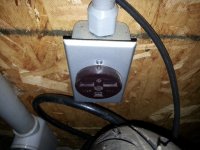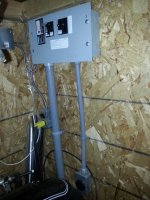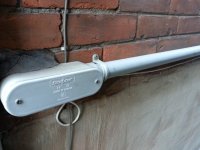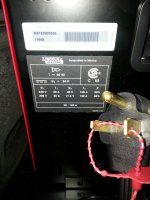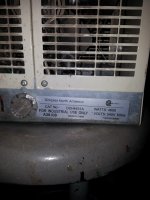We noticed you are blocking ads. DO THE TON only works with community supporters. Most are active members of the site with small businesses. Please consider disabling your ad blocking tool and checking out the businesses that help keep our site up and free.
You are using an out of date browser. It may not display this or other websites correctly.
You should upgrade or use an alternative browser.
You should upgrade or use an alternative browser.
Recommendation for a welder
- Thread starter Tim
- Start date
cqyqte
Grumpy retired oldtimer... "eat a Snickers bar"
I forgot about the way cityslickers think, in the country everything is 20 minutes away. We get used to driving/riding distances to pick things up as well as planning routes to optimize the trip.... heheheh! There's is no worse feeling than to make the trek to the hardware store for nuts and bolts or a part, to find you didn't have that piece you thought you did when you return. So we buy everything for the job when we are there regardless if we are sure we have one or not.... just means our garages are full of extra bits and pieces that we don't need at the moment!!
cqyqte said:I forgot about the way cityslickers think, in the country everything is 20 minutes away. We get used to driving/riding distances to pick things up as well as planning routes to optimize the trip.... heheheh! There's is no worse feeling than to make the trek to the hardware store for nuts and bolts or a part, to find you didn't have that piece you thought you did when you return. So we buy everything for the job when we are there regardless if we are sure we have one or not.... just means our garages are full of extra bits and pieces that we don't need at the moment!!
Trust me, I buy 10 of everything usually. And the nearest welding tank is going to be a solid 20-30 mins from home. Orangeville however is over an hour each way
Just need to sort out electrical. I have an outlet in the garage for my heater, and I'd like to keep it available. So I might sort out a 2 foot 'extension cord' for the welder to plug into the existing outlet. Otherwise a 2nd wall outlet and a junction box for the heater / welder outlets and only use one at a time.
B
bluenose bomber
Guest
Tim, look at a dryer "extention cord" for your welder if the plug configuration is OK. Other wise, may i Suggest either an Amp plug/ socket or a Leviton plug/socket setup. Both available from places such as Home Depot, Rona, CTC or an electrical supply house. Crouse Hinds is really nice but many $$$. What you want is to make sure a 110 cannot be plugged into the 220. Personally, I wouldn't add a 2nd out let unless I had it looked at by an electrician. Licensed, experienced and reliable of course.
Yeah - my first inclination was to put an outlet on the wall, with a cord / male plug coming out the bottom to plug into my existing outlet. Basically a wall mounted 'extension cord' with only about 18 inches of cable. Just mount the outlets next to each other (although having the welder outlet in another spot might be useful).
Will look into the plug/socket setups you mentioned.
Will look into the plug/socket setups you mentioned.
B
bluenose bomber
Guest
Tim, you want to look at what your total load draw (amps) will be with everything running. 115 v Lights don't draw a lot, amp or so depending on wattage and type. CF's or LEDs are the lowest. . The 230v heater will cycle its load via the thermostat and draw fully when on. Heater should be on a 20. Welder will draw fully when striking an arc. Maybe a 20 also. Your total running load cannot, repeat cannot, exceed your garage breaker rating ( in the main panel) which supplies power to the garage. Check rating of supply breaker in the house panel. Depending on its rating you may be able to run both welder and heater together. (Canadian winters are cruel at best). The heater and welder will each have total load ratings printed on a label somewhere on the case. Add them up and compare to garage supply breaker in the house. Above all, don't increase the amp rating of the existing breaker in the house to allow for more power in the garage. You said you had a 100 amp main panel. You may be running very close to that. limit.
cqyqte
Grumpy retired oldtimer... "eat a Snickers bar"
+1 on that Tim, boy Blue is absolutely right on that. I know because we ran tests at CSA where we juiced up NMD-7 14AWG to 20 A (normally what 12AWG is rated) and ran the cable through mocked up walls with insulation and after the tests the wire insulation is melted together with the fibreglass insulation like a corndog. There are very good reasons for the ratings and rules in Part 1 of the CEC. 
The garage is on a 40A circuit from my main house panel (2 pole 40A breaker). I'm pretty sure it's 8 gauge wire. It's an insulated cable, not individual conductors. Run in 1.25" conduit to the garage panel, about 75 feet or so total distance panel to panel.
In the garage I've got the panel with 2 15A breakers and one 2 pole 30A breaker setup. One 15A is GFCI running a hot tub, the other is for the garage lights, opener etc. The 30A is dedicated to my little heater at the moment.
In the garage I've got the panel with 2 15A breakers and one 2 pole 30A breaker setup. One 15A is GFCI running a hot tub, the other is for the garage lights, opener etc. The 30A is dedicated to my little heater at the moment.
Attachments
Oh and I should say I've never popped a breaker. The tub runs all year (heating right now) and I've spent hours in the garage with the heater running full blast and using my 4 sets of 4 foot long 2 bulb florescent lights and whatever drill or grinder I happened to have in my hands.
Actually doing some reading and it may be that the wire in my conduit isn't quite up to snuff - the conduit runs outdoors and a short section under ground, which I think qualifies it as a 'wet' situation. Should have had THWN or XHHW in it perhaps.
Might consider upgrading the wiring. Currently the garage is running off a 2 pole 40A breaker as mentioned. On my house panel I have an unused 2 pole 20A breaker as well (for some long gone baseboard heaters I think). I have to add up all the breakers on my panel, but it might be I could have a larger service to the garage if I had THWN pulled through the 1 1/4" conduit.
Looking for input Don't mind doing it right if it means I get upgraded service to my garage and can run the heater and welder together. Only thing I can't change is the 1 1/4" conduit. Good news is all the conduit fill charts suggest I can have 11 #6 THHN conductors in my 1 1/4" conduit so it would seem I have more than enough room in the pipe for lower gauge wiring if needed.
Don't mind doing it right if it means I get upgraded service to my garage and can run the heater and welder together. Only thing I can't change is the 1 1/4" conduit. Good news is all the conduit fill charts suggest I can have 11 #6 THHN conductors in my 1 1/4" conduit so it would seem I have more than enough room in the pipe for lower gauge wiring if needed.
Might consider upgrading the wiring. Currently the garage is running off a 2 pole 40A breaker as mentioned. On my house panel I have an unused 2 pole 20A breaker as well (for some long gone baseboard heaters I think). I have to add up all the breakers on my panel, but it might be I could have a larger service to the garage if I had THWN pulled through the 1 1/4" conduit.
Looking for input
B
bluenose bomber
Guest
From what I see and read, you are at the limit (maybe even over) of your garage panels capacity. The heater would use 20 A. Your panel capacity is now in 1/2. Lights 2, maybe 3. Tub heater, don't know,maybe 6 to 10. Welder, at least 30. What I see, no room for separate circuits for heater and welder.
Options:
1- install a 60 amp, if allowed in Ontario or better yet, a 100 Amp service in garage, more circuits available, upgrade supply wires,, new panel and have a separate supply from hydro pole.. This would mean a separate meter, read bill, for the garage.
2-Upgrade your house to 200 Amp. and then upgrade the garage via a 50 or 60 amp from the house with #3 or #4 wires
3- leave it alone. plug welder in after taking heater out and hope you don't trip the house breaker.
4- run a separate wire to the garage from the old house heater circuit for the welder. It is a pain in the rear to fish wire through existing conduit though you could run in a Tech cable separately to the garage.
This would still put you over the present capacity of your houses main breaker and wires. I think you haven't tripped the breaker because you are slightly under the 40 amp house breaker limit right now. Your garage heater has an over capacity breaker, you could go to a 25 or even a 20 (which is too close IMO unless it would have a delayed trip). Having said all that, my suggestion is to take option 2 as a first choice and Option 1 as a second choice.. Either way, it will cost a lot of money which is another matter. Most of these will cost. I'm also not sure how Ontario ensures CEC compliance. Here in NS, all of that is done through NS Power and permits are only given to licensed electricians
Above all, "do not' put a bigger breaker in the house to replace the 40 that is there. Also a dryer plug won't work as it is made for 230/115 volts
Hope some of this helps. BTW, your doing a good job as Moderator.
Options:
1- install a 60 amp, if allowed in Ontario or better yet, a 100 Amp service in garage, more circuits available, upgrade supply wires,, new panel and have a separate supply from hydro pole.. This would mean a separate meter, read bill, for the garage.
2-Upgrade your house to 200 Amp. and then upgrade the garage via a 50 or 60 amp from the house with #3 or #4 wires
3- leave it alone. plug welder in after taking heater out and hope you don't trip the house breaker.
4- run a separate wire to the garage from the old house heater circuit for the welder. It is a pain in the rear to fish wire through existing conduit though you could run in a Tech cable separately to the garage.
This would still put you over the present capacity of your houses main breaker and wires. I think you haven't tripped the breaker because you are slightly under the 40 amp house breaker limit right now. Your garage heater has an over capacity breaker, you could go to a 25 or even a 20 (which is too close IMO unless it would have a delayed trip). Having said all that, my suggestion is to take option 2 as a first choice and Option 1 as a second choice.. Either way, it will cost a lot of money which is another matter. Most of these will cost. I'm also not sure how Ontario ensures CEC compliance. Here in NS, all of that is done through NS Power and permits are only given to licensed electricians
Above all, "do not' put a bigger breaker in the house to replace the 40 that is there. Also a dryer plug won't work as it is made for 230/115 volts
Hope some of this helps. BTW, your doing a good job as Moderator.
Thanks for the input (again)!
So for the interim, can I mount an outlet on the wall with a short cable/plug to connect to the heater outlet? Just as an adapter to be able to plug the welder into the 30A heater circuit.
I hadn't anticipated being able to run both welder and heater together, and it's only a few months of the year that I need the heater on anyhow. The garage is insulated so once it's warm, I can unplug the heater to do a bit of welding and then plug it back in no problem.
So for the interim, can I mount an outlet on the wall with a short cable/plug to connect to the heater outlet? Just as an adapter to be able to plug the welder into the 30A heater circuit.
I hadn't anticipated being able to run both welder and heater together, and it's only a few months of the year that I need the heater on anyhow. The garage is insulated so once it's warm, I can unplug the heater to do a bit of welding and then plug it back in no problem.
Figured I'd follow this up with the results from my first ever welding session. Did a 6 hour MIG intro at Centennial College. Light on the theory, heavy on the lab time. So I got to spend a few hours playing around with a Lincoln 140 setup and lots of 14 and 22 ga metal. Tried a couple pieces of thicker material (3 gauge - 0.18 inch) for a T joint. Nice looking but not a ton of penetration at full amperage.
First ever welds from left to right. Just laying a bead down and then did some joints. Butt, lap, T.

The pile of junk I finished off with - all sorts of corner joints, stitching, straight beads...

And the thicker material T joint. Had it maxed out and had to go pretty slow to maintain the 'sizzle'.
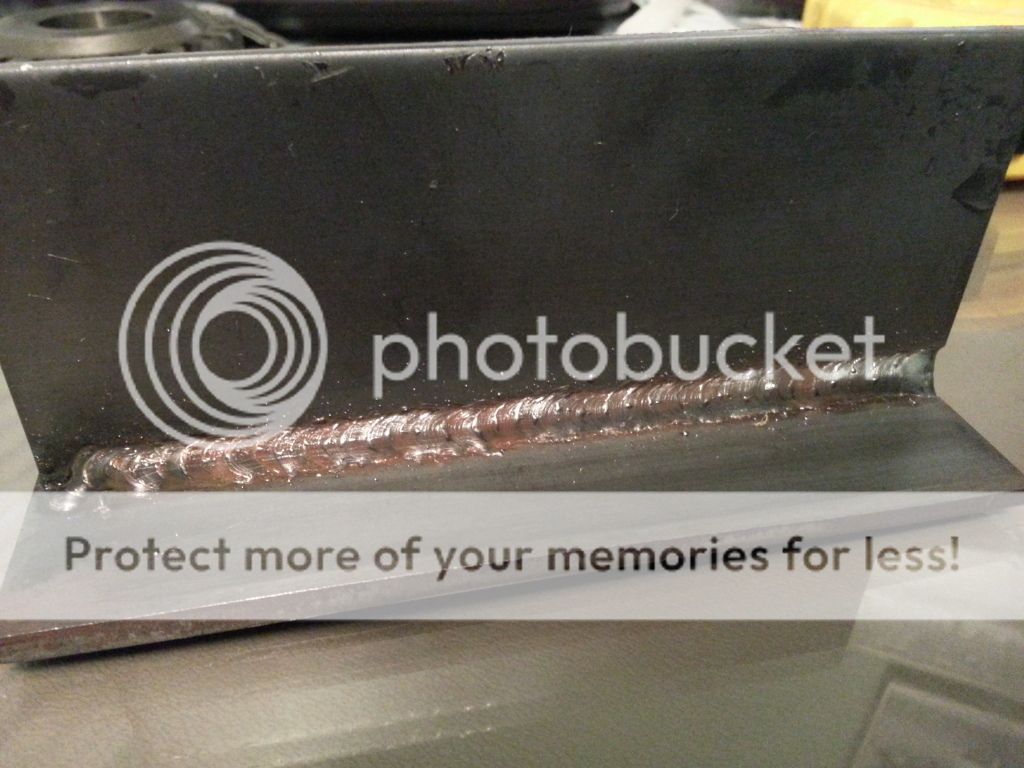

First ever welds from left to right. Just laying a bead down and then did some joints. Butt, lap, T.

The pile of junk I finished off with - all sorts of corner joints, stitching, straight beads...

And the thicker material T joint. Had it maxed out and had to go pretty slow to maintain the 'sizzle'.


Well, I had a lot of good advice and watched a lot of videos. The little swoop recursive e pattern helped me a lot - builds a rhythm to steady your speed and gives the nice pattern. Played with the voltage and wire speed - getting the hang of when to turn what in which direction. The unit I was working with at the college was one of Lincolns' direct sales more expensive models with the metal wire drive and the stepless adjusters. Mine is the retail model with the resin wire drive and stepped speed and voltage adjusters. But I'm confident I'll be fine. Probably a mod out there to make the dials stepless.
One thing I'm unclear of - when you blow through the material, especially the thinner stuff, what do you do? I mean, I can't believe that if you blow through a weld on a gas tank you just built the whole thing is scrap. Can you fill it in with weld, or do you need to cut the section out and patch with new steel?
Anyhow - was a lot of fun and confidence inspiring. Ready to tackle my trailer when it warms up and maybe do some work on my SR500. The MK4 will be TIG welded when it comes time to add the brackets to it, as they're all visible welds and the frame is too pretty to mess up.
One thing I'm unclear of - when you blow through the material, especially the thinner stuff, what do you do? I mean, I can't believe that if you blow through a weld on a gas tank you just built the whole thing is scrap. Can you fill it in with weld, or do you need to cut the section out and patch with new steel?
Anyhow - was a lot of fun and confidence inspiring. Ready to tackle my trailer when it warms up and maybe do some work on my SR500. The MK4 will be TIG welded when it comes time to add the brackets to it, as they're all visible welds and the frame is too pretty to mess up.


